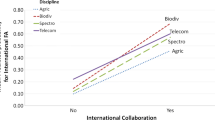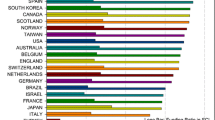Abstract
This study analyzed journal articles published by authors from the G9 countries (Canada, China, France, Germany, Italy, Japan, Russia, the United Kingdom, and the United States) to identify the distribution of research funding and funding agencies in these countries. A total of 5,856,744 articles published between 2009 and 2014 were collected from the Web of Science database. The results showed that China had the highest proportion of funded papers among its overall scientific output, while Italy had the lowest funded paper ratio. The leading sponsoring countries of papers by other countries were China and the United States, with China having a sponsorship surplus with all the other G9 countries, and the United States having a sponsorship surplus with seven other countries excepting China. Furthermore, governmental agencies were the major sponsors of funded papers in the G9 countries. The field of life sciences had the highest proportion of funded papers among the field’s total paper output; while natural sciences had the highest proportion of papers among all funded papers of a country. Regarding funding agencies, the top three funding agencies in each G9 country were primarily domestic agencies; and a large proportion of the funding provided by these agencies were granted to domestic research projects.

Similar content being viewed by others
References
Abt, H. A. (1984). Citations to federally-funded and unfunded research. Publications of the Astronomical Society of the Pacific, 96(581), 563–565.
Álvarez-Bornstein, B., Morillo, F., & Bordons, M. (2017). Funding acknowledgments in the Web of Science: Completeness and accuracy of collected data. Scientometrics, 112(3), 1793–1812.
Amiri, A. R., Kanesalingam, K., Cro, S., & Casey, A. T. H. (2014). Does source of funding and conflict of interest influence the outcome and quality of spinal research? The Spine Journal, 14, 308–314.
Bloch, C., Sorensen, M. P., Graversen, E. K., Schneider, J. W., Schmidt, E. K., Aagaard, K., et al. (2014). Developing a methodology to assess the impact of research grant funding: A mixed methods approach. Evaluation and Program Planning, 43, 105–117.
Bolli, T., & Somogyi, F. (2011). Do competitively acquired funds induce universities to increase productivity? Research Policy, 40(1), 136–147.
Braun, D. (1998). The role of funding agencies in the cognitive development of science. Research Policy, 27, 807–821.
Chou, Y. (2009). Gai ge kai fang yi lai zhong guo yan fa tou ru de xian zhuang ji guo ji bi jiao (1978–2003). Researches in Chinese Economic History, 2009(1), 62–70.
Cordero, C., Delino, R., Jeyaseelan, L., Lansang, M. A., Lozano, J. M., Kumar, S., et al. (2008). Funding agencies in low- and middle-income countries: Support for knowledge translation. Bulletin of the World Health Organization, 86(7), 524–534.
Costas, R., & van Leeuwen, T. N. (2012). Approaching the “reward triangle”: General analysis of the presence of funding acknowledgments and “peer interactive communication” in scientific publications. Journal of the Association for Information Science and Technology, 63(8), 1647–1661.
Grimpe, C. (2012). Extramural research grants and scientists’ funding strategies: Beggars cannot be choosers? Research Policy, 41, 1448–1460.
Jowkar, A., Didegah, F., & Gazni, A. (2011). The effect of funding on academic research impact: A case study of Iranian publications. Aslib Proceedings, 63(6), 593–602.
Leydesdorff, L. (2003). The mutual information of university-industry-government relations: An indicator of the Triple Helix dynamics. Scientometrics, 58(2), 445–467.
Ministry of Science and Technology. (2008). The development of science and research in Italy. Retrieved from https://www.most.gov.tw/france/ch/detail?article_uid=3044b96f-7559-4e48-bbfd-321412d90566&menu_id=c5472577-1efa-4d84-aa70-4e78f2e2614f&content_type=P&view_mode=listView.
Ministry of Science and Technology. (2009). Centre national de la recherché scientifique(CNRS). Retrieved from https://www.most.gov.tw/france/ch/detail?article_uid=45229bbd-f618-4ce4-8449-10aa6c2fc3aa&menu_id=31acd9c9-c28a-4422-99b3-6e0da6803ac3&content_type=P&view_mode=listView.
NTU Ranking. (2016). Performance ranking of scientific papers for world universities 2016: Field categories. Retrieved from http://nturanking.lis.ntu.edu.tw/BackgroundMethodology/FieldCategories-enus.aspx.
Salter, A. J., & Martin, B. R. (2001). The economic benefits of publicly funded basic research: A critical review. Research Policy, 30, 509–532.
Scott, A., & Smith, T. (2014). National Science Foundation. Retrieved from https://www.aaas.org/sites/default/files/migrate/uploads/14pch06.pdf.
Shibayama, S. (2011). Distribution of academic research funds: Case of Japanese national research grant. Scientometrics, 88(1), 43–60.
Tan, A. M., Zhao, S. X., & Ye, F. Y. (2012). Funds promote scientific output. Current Science, 102(4), 542–543.
Tang, L., Hu, G., & Liu, W. (2017). Funding acknowledgment analysis: Queries and caveats. Journal of the Association for Information Science and Technology, 68(3), 790–794.
Tian, J. M. (2010). Zhong guo de yan fa zhi chu ji ju zeng jia. Guo Ji Jing Ji Qing Shi Shuang Zhou Bao, 1731, 5–17.
Walentas, C. D., Shineman, D. W., Horton, A. R., Boeve, B. F., & Fillit, H. M. (2011). An analysis of global research funding for the frontotemporal dementias: 1998–2008. Alzheimers Dement, 7(2), 142–150.
Wang, X. W., Liu, D., Ding, K., & Wang, X. R. (2012). Science funding and research output: A study on 10 countries. Scientometrics, 91(2), 591–599.
Wang, J., & Shapira, P. (2011). Funding acknowledgement analysis: An enhanced tool to investigate research sponsorship impacts: The case of nanotechnology. Scientometrics, 87(3), 563–586.
Yang, W. (2015). National Natural Science Foundation of China annual report 2014. Retrieved from http://www.nsfc.gov.cn/nsfc/cen/ndbg/2014ndbg/qy.html.
Zhao, D. (2010). Characteristics and impact of grant-funded research: A case study of the library and information science field. Scientometrics, 84(2), 293–306.
Author information
Authors and Affiliations
Corresponding author
Rights and permissions
About this article
Cite this article
Huang, MH., Huang, MJ. An analysis of global research funding from subject field and funding agencies perspectives in the G9 countries. Scientometrics 115, 833–847 (2018). https://doi.org/10.1007/s11192-018-2677-y
Received:
Published:
Issue Date:
DOI: https://doi.org/10.1007/s11192-018-2677-y




